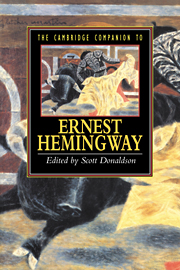Book contents
- Frontmatter
- 1 Introduction
- 2 Hemingway's journalism and the realist dilemma
- 3 1924
- 4 In Our Time, out of season
- 5 Brett and the other women in The Sun Also Rises
- 6 A Farewell to Arms
- 7 Hemingway's late fiction
- 8 Hemingway and politics
- 9 Hemingway and gender history
- 10 Hemingway, Hadley, and Paris
- 11 Hemingway's Spanish sensibility
- 12 The Cuban context of The Old Man and the Sea
- 13 Conclusion
- Selected Bibliography
- Index
- Series List
11 - Hemingway's Spanish sensibility
Published online by Cambridge University Press: 28 May 2006
- Frontmatter
- 1 Introduction
- 2 Hemingway's journalism and the realist dilemma
- 3 1924
- 4 In Our Time, out of season
- 5 Brett and the other women in The Sun Also Rises
- 6 A Farewell to Arms
- 7 Hemingway's late fiction
- 8 Hemingway and politics
- 9 Hemingway and gender history
- 10 Hemingway, Hadley, and Paris
- 11 Hemingway's Spanish sensibility
- 12 The Cuban context of The Old Man and the Sea
- 13 Conclusion
- Selected Bibliography
- Index
- Series List
Summary
[America] had been a good country and we had made a bloody mess of it.
- GHOA 285He was in Spain, inside Spain, living her life. And his two great works, For Whom the Bell Tolls and The Sun Also Rises, blossomed out of this implantation of the roots of that powerful American tree into Iberian soil
- Salvador de MadariagaErnest Hemingway wrote about many places - northern Michigan; France and Italy; Key West, Havana, and Bimini; East Africa - but no place had the effect on him, as a person or as a writer, that Spain did. In the second sentence of his last book, The Dangerous Summer, Hemingway claimed to like Spain better than any country except his own, and privately he said he loved Spain more than any place. To understand how and why Spain affected him so deeply is to explore the most profound mysteries of Hemingway's craft, both as stylist and as creator of narrative fiction.
The effect of place on writers is well known, especially the home place: William Faulkner's northern Mississippi or Thomas Wolfe's North Carolina highlands come readily to mind as examples. With Hemingway the case is quite different. He wrote very little about his hometown of Oak Park or nearby Chicago. Nick Adams, one of his most autobiographical characters, thinks in the story “The Killers” that he ought to get out of town. Hemingway himself did virtually the same and seldom returned.
- Type
- Chapter
- Information
- The Cambridge Companion to Hemingway , pp. 221 - 242Publisher: Cambridge University PressPrint publication year: 1996
- 1
- Cited by



